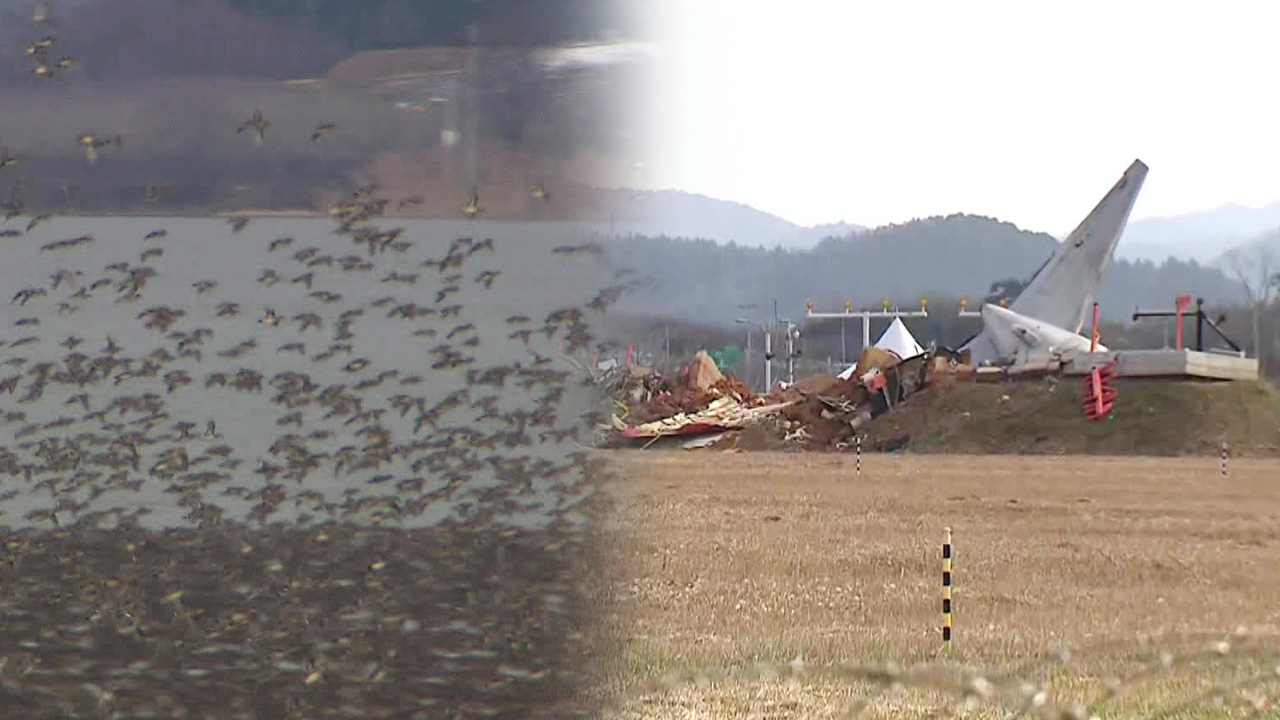Traces of mallard in Jeju Air engines
입력 2025.01.25 (23:36)
읽어주기 기능은 크롬기반의
브라우저에서만 사용하실 수 있습니다.
[Anchor]
Now, let's take a look at the Jeju Air passenger plane disaster.
Traces of the migratory bird, the mallard, were found in both engines of the accident-incurred aircraft.
Additionally, the moment the aircraft made contact with a flock of birds after declaring an emergency was captured on CCTV.
Kim Jin-hwa reports.
[Report]
Muan Airport, located near a migratory bird habitat.
[Lee Gi-woo/Resident near Muan International Airport: "In winter, many migratory birds come through. Geese and ducks, these types of birds gather together."]
In fact, the blood and feathers found in both engines of the accident aircraft were identified as belonging to mallard.
Mallard are the most common winter migratory birds in the country, with tens of thousands to hundreds of thousands living in flocks.
CCTV at Muan Airport also captured the accident-incurred aircraft, which was heading north after declaring an emergency, making contact with a flock of birds.
However, further investigation is needed to determine if other types of birds were involved in the collision and how many were hit.
The situation just before the collision, recorded in the black box and communication logs, has also been revealed.
The Jeju Air passenger plane, which was descending for landing, received a bird activity warning at 8:57:50 AM.
About 20 seconds later, a conversation among the pilots recorded that "there are birds below the airplane."
Until this point, the black box was still operational.
However, from 8:58:50 AM, both the voice and flight data recording devices stopped, and the pilots declared an emergency while increasing the flight altitude.
[Ko Seung-hee/Professor of Aviation Operations at Shilla University: "The generator inside the engine, which produces electricity, must operate to supply power to the onboard equipment and instruments. There is a battery, but it is not connected to the FDR (Flight Data Recorder) and CVR."]
The accident investigation committee explained the preliminary investigation results to the families of the victims today (Jan. 25).
[Park Han-shin/Representative of the Victims' Families Association: "(The results of this investigation) are basic, and we trust that they will calmly explain future accident investigation to us..."]
Separate research will be commissioned regarding the localizer mound, which has been identified as a contributing factor to the severity of the incident.
KBS News, Kim Jin-hwa.
Now, let's take a look at the Jeju Air passenger plane disaster.
Traces of the migratory bird, the mallard, were found in both engines of the accident-incurred aircraft.
Additionally, the moment the aircraft made contact with a flock of birds after declaring an emergency was captured on CCTV.
Kim Jin-hwa reports.
[Report]
Muan Airport, located near a migratory bird habitat.
[Lee Gi-woo/Resident near Muan International Airport: "In winter, many migratory birds come through. Geese and ducks, these types of birds gather together."]
In fact, the blood and feathers found in both engines of the accident aircraft were identified as belonging to mallard.
Mallard are the most common winter migratory birds in the country, with tens of thousands to hundreds of thousands living in flocks.
CCTV at Muan Airport also captured the accident-incurred aircraft, which was heading north after declaring an emergency, making contact with a flock of birds.
However, further investigation is needed to determine if other types of birds were involved in the collision and how many were hit.
The situation just before the collision, recorded in the black box and communication logs, has also been revealed.
The Jeju Air passenger plane, which was descending for landing, received a bird activity warning at 8:57:50 AM.
About 20 seconds later, a conversation among the pilots recorded that "there are birds below the airplane."
Until this point, the black box was still operational.
However, from 8:58:50 AM, both the voice and flight data recording devices stopped, and the pilots declared an emergency while increasing the flight altitude.
[Ko Seung-hee/Professor of Aviation Operations at Shilla University: "The generator inside the engine, which produces electricity, must operate to supply power to the onboard equipment and instruments. There is a battery, but it is not connected to the FDR (Flight Data Recorder) and CVR."]
The accident investigation committee explained the preliminary investigation results to the families of the victims today (Jan. 25).
[Park Han-shin/Representative of the Victims' Families Association: "(The results of this investigation) are basic, and we trust that they will calmly explain future accident investigation to us..."]
Separate research will be commissioned regarding the localizer mound, which has been identified as a contributing factor to the severity of the incident.
KBS News, Kim Jin-hwa.
■ 제보하기
▷ 카카오톡 : 'KBS제보' 검색, 채널 추가
▷ 전화 : 02-781-1234, 4444
▷ 이메일 : kbs1234@kbs.co.kr
▷ 유튜브, 네이버, 카카오에서도 KBS뉴스를 구독해주세요!
- Traces of mallard in Jeju Air engines
-
- 입력 2025-01-25 23:36:14

[Anchor]
Now, let's take a look at the Jeju Air passenger plane disaster.
Traces of the migratory bird, the mallard, were found in both engines of the accident-incurred aircraft.
Additionally, the moment the aircraft made contact with a flock of birds after declaring an emergency was captured on CCTV.
Kim Jin-hwa reports.
[Report]
Muan Airport, located near a migratory bird habitat.
[Lee Gi-woo/Resident near Muan International Airport: "In winter, many migratory birds come through. Geese and ducks, these types of birds gather together."]
In fact, the blood and feathers found in both engines of the accident aircraft were identified as belonging to mallard.
Mallard are the most common winter migratory birds in the country, with tens of thousands to hundreds of thousands living in flocks.
CCTV at Muan Airport also captured the accident-incurred aircraft, which was heading north after declaring an emergency, making contact with a flock of birds.
However, further investigation is needed to determine if other types of birds were involved in the collision and how many were hit.
The situation just before the collision, recorded in the black box and communication logs, has also been revealed.
The Jeju Air passenger plane, which was descending for landing, received a bird activity warning at 8:57:50 AM.
About 20 seconds later, a conversation among the pilots recorded that "there are birds below the airplane."
Until this point, the black box was still operational.
However, from 8:58:50 AM, both the voice and flight data recording devices stopped, and the pilots declared an emergency while increasing the flight altitude.
[Ko Seung-hee/Professor of Aviation Operations at Shilla University: "The generator inside the engine, which produces electricity, must operate to supply power to the onboard equipment and instruments. There is a battery, but it is not connected to the FDR (Flight Data Recorder) and CVR."]
The accident investigation committee explained the preliminary investigation results to the families of the victims today (Jan. 25).
[Park Han-shin/Representative of the Victims' Families Association: "(The results of this investigation) are basic, and we trust that they will calmly explain future accident investigation to us..."]
Separate research will be commissioned regarding the localizer mound, which has been identified as a contributing factor to the severity of the incident.
KBS News, Kim Jin-hwa.
Now, let's take a look at the Jeju Air passenger plane disaster.
Traces of the migratory bird, the mallard, were found in both engines of the accident-incurred aircraft.
Additionally, the moment the aircraft made contact with a flock of birds after declaring an emergency was captured on CCTV.
Kim Jin-hwa reports.
[Report]
Muan Airport, located near a migratory bird habitat.
[Lee Gi-woo/Resident near Muan International Airport: "In winter, many migratory birds come through. Geese and ducks, these types of birds gather together."]
In fact, the blood and feathers found in both engines of the accident aircraft were identified as belonging to mallard.
Mallard are the most common winter migratory birds in the country, with tens of thousands to hundreds of thousands living in flocks.
CCTV at Muan Airport also captured the accident-incurred aircraft, which was heading north after declaring an emergency, making contact with a flock of birds.
However, further investigation is needed to determine if other types of birds were involved in the collision and how many were hit.
The situation just before the collision, recorded in the black box and communication logs, has also been revealed.
The Jeju Air passenger plane, which was descending for landing, received a bird activity warning at 8:57:50 AM.
About 20 seconds later, a conversation among the pilots recorded that "there are birds below the airplane."
Until this point, the black box was still operational.
However, from 8:58:50 AM, both the voice and flight data recording devices stopped, and the pilots declared an emergency while increasing the flight altitude.
[Ko Seung-hee/Professor of Aviation Operations at Shilla University: "The generator inside the engine, which produces electricity, must operate to supply power to the onboard equipment and instruments. There is a battery, but it is not connected to the FDR (Flight Data Recorder) and CVR."]
The accident investigation committee explained the preliminary investigation results to the families of the victims today (Jan. 25).
[Park Han-shin/Representative of the Victims' Families Association: "(The results of this investigation) are basic, and we trust that they will calmly explain future accident investigation to us..."]
Separate research will be commissioned regarding the localizer mound, which has been identified as a contributing factor to the severity of the incident.
KBS News, Kim Jin-hwa.
-
-

김진화 기자 evolution@kbs.co.kr
김진화 기자의 기사 모음
-
이 기사가 좋으셨다면
-
좋아요
0
-
응원해요
0
-
후속 원해요
0















이 기사에 대한 의견을 남겨주세요.